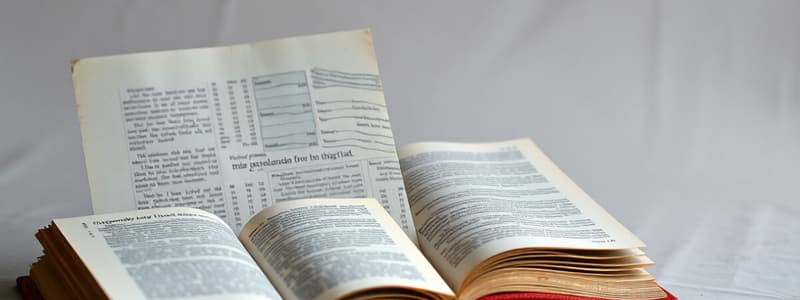Podcast
Questions and Answers
What is one defining characteristic of indigenous knowledge?
What is one defining characteristic of indigenous knowledge?
- It is usually formalized in academic settings.
- It is primarily written down in books.
- It has a universal application across all cultures.
- It is transmitted through oral tradition. (correct)
Which source of information is NOT classified as a type of library?
Which source of information is NOT classified as a type of library?
- Special Library
- Public Library
- Field Research Library (correct)
- Academic Library
What does the term 'reliability' refer to in the context of fact-checking?
What does the term 'reliability' refer to in the context of fact-checking?
- The frequency of the information being updated.
- The prestige of the source providing the information.
- The amount of information available online.
- The relevance and trustworthiness of the information. (correct)
Which form of indigenous media is characterized by face-to-face interaction?
Which form of indigenous media is characterized by face-to-face interaction?
What type of library serves specific specialized environments, such as hospitals and museums?
What type of library serves specific specialized environments, such as hospitals and museums?
What is the primary purpose of clickbait in media?
What is the primary purpose of clickbait in media?
Which definition describes propaganda in media?
Which definition describes propaganda in media?
What is sloppy journalism most likely to result in?
What is sloppy journalism most likely to result in?
What does the term 'microtargeting' refer to in the context of social media?
What does the term 'microtargeting' refer to in the context of social media?
How does circular reporting lead to misinformation?
How does circular reporting lead to misinformation?
Flashcards
Indigenous Knowledge
Indigenous Knowledge
Unique knowledge specific to a culture or society, often passed down orally.
Primary Sources
Primary Sources
Original materials, firsthand accounts, or data.
Library
Library
A place that stores and provides access to books, recordings, or other reference materials.
Internet
Internet
Signup and view all the flashcards
Indigenous Media
Indigenous Media
Signup and view all the flashcards
Clickbait
Clickbait
Signup and view all the flashcards
Propaganda
Propaganda
Signup and view all the flashcards
Sloppy Journalism
Sloppy Journalism
Signup and view all the flashcards
Bots
Bots
Signup and view all the flashcards
Microtargeting
Microtargeting
Signup and view all the flashcards
Study Notes
Media and Information Sources
- Three main sources: indigenous knowledge, libraries, and the internet
- Fact-checking includes authenticity (originality/legitimacy), validity (accuracy/precision), and reliability (relevance/timeliness)
- Indigenous knowledge: unique to a culture/society, often passed down orally, preserved through local channels, and adapted
Characteristics of Indigenous Knowledge
- Oral tradition of communication
- Memorized information; face-to-face exchange
- Information contained within the community
Indigenous Media
- Indigenous expressions, conceptualized, produced, and circulated by indigenous peoples globally
- Forms:
- Folk/traditional media
- Gatherings/social organizations
- Direct observation
- Records (written, carved, oral)
- Oral instruction
Types of Libraries
- Academic libraries: serve colleges/universities
- Public libraries: serve cities/towns
- School libraries: serve K-12 students
- Special libraries: specialized environments (hospitals, corporations, museums, the military, private business, government)
Classifications of Information Sources
Primary Sources
- Original materials, from a specific period
- Unfiltered, unmodified, no analysis/interpretation/evaluation
- Examples: artifacts, diaries, patents, audio-visual recordings
Secondary Sources
- Written after an original product
- Reflection/analysis of evidence, not proof itself
- Types: index, survey, reference
Tertiary Sources
- Collect and organize primary and secondary sources
- Examples: bibliographies, directories, yearbooks, guides, research progress lists
Studying That Suits You
Use AI to generate personalized quizzes and flashcards to suit your learning preferences.




